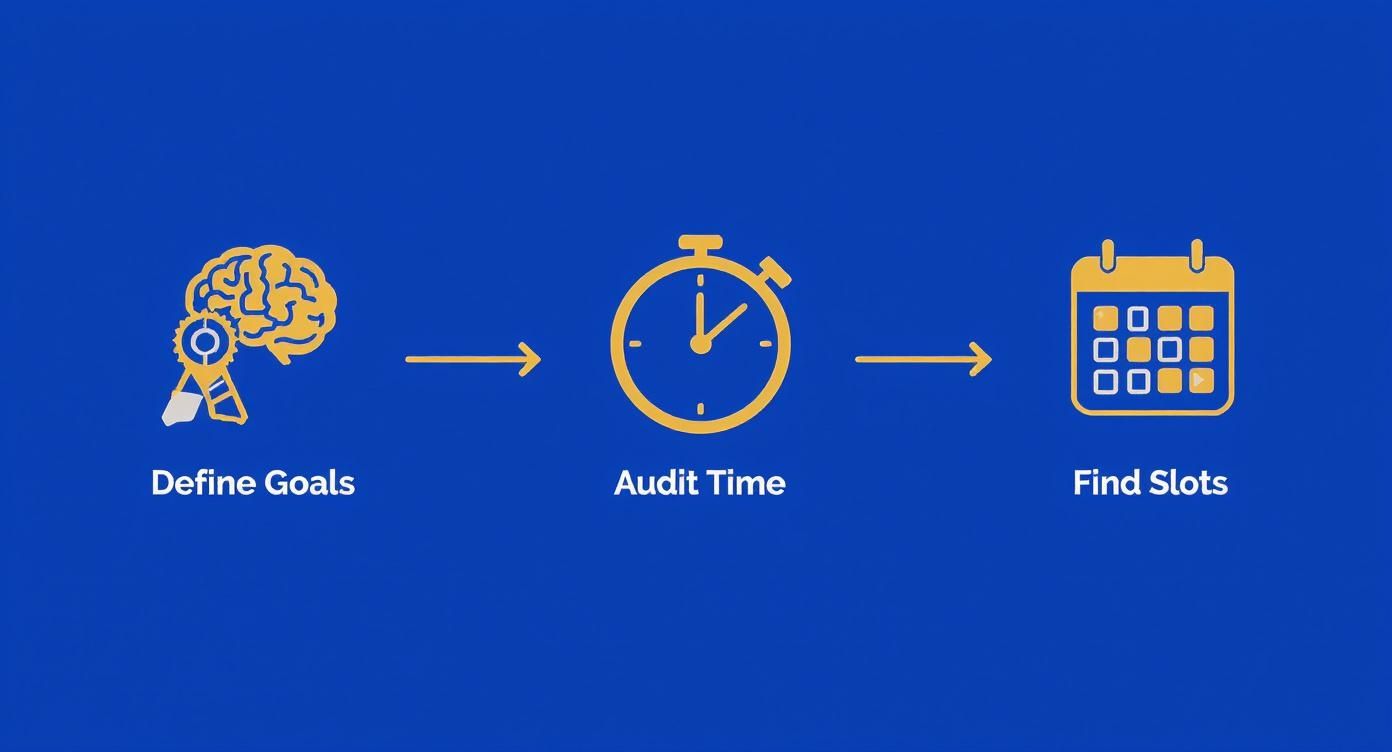
Are you starting an online course but worried about fitting it all in? You're not alone. The key to success isn't about finding more hours in the day; it's about making the hours you have work for you. Crafting a solid study plan comes down to three simple steps: understanding your goals, scheduling your time wisely, and choosing a course that fits your life. This guide will show you how to create a flexible roadmap that turns big academic goals into small, manageable daily wins.
Why You Need a Realistic Study Plan for Online Learning
The initial excitement of starting an online course is powerful, but long-term success is built on a smart, practical plan. Think of your study plan not as a rigid timetable, but as your personal guide that bends with your life. It helps you stay in control and avoid the overwhelm that often trips up online learners.

This kind of planning has never been more vital. With 68% of UK students now working part-time, independent study time has been squeezed down to just 11.6 hours per week. A realistic plan is your secret weapon for successfully juggling these competing demands.
Turning Ambition Into Action
A well-designed plan is the bridge between clicking 'enrol' and earning your qualification. It’s how you make steady, tangible progress without the pressure of a traditional classroom setting.
A good plan helps you:
-
Avoid Burnout: By scheduling proper breaks and respecting your limits, you keep your energy and motivation high for the long haul.
-
Stay Accountable: It gives you a clear benchmark to track your progress and celebrate those small victories that keep you going.
-
Maximise Your Time: You can dedicate your most productive hours to learning, ensuring every study session counts.
Ultimately, knowing the 4 study skills every learner needs and applying them within a structured plan is your best strategy for success.
Step 1: Map Out Your Goals and Commitments
Before you open a single textbook, take a step back. The first move is to get a clear picture of what you’re working with. Start by defining your 'why'.
Are you aiming to switch careers? Are you chasing a promotion, or is this about pursuing a personal passion? Your motivation is the fuel that will keep you going when the going gets tough.
Next, it's time for an honest time audit. Grab a piece of paper or open a spreadsheet and map out your typical week. Fill in all the non-negotiables first – work hours, family duties, appointments, and yes, that essential downtime to recharge. This isn't about finding extra hours; it's about seeing where studying can realistically fit.
This reality check is crucial, especially for adult learners. A recent survey showed that 48% of students have considered dropping out due to money worries, with over 80% concerned about making ends meet. Your study plan must work around your life, including your job and self-care, or you risk burning out. You can read more about these financial pressures in the full report.
Define Your Starting Point
Once you can see your entire week laid out, you can start to spot potential gaps for study.
It's all about finding those pockets of opportunity:
-
Could you use your lunch break for a quick 30-minute review?
-
Is there a quiet hour in the evening after the kids are in bed?
-
Are weekend mornings when you feel sharpest and most productive?
Here's a simple template to get you started. Mapping this out can be a real eye-opener, showing you where your time actually goes.
Your Weekly Time Audit Template
Use this simple template to map your current commitments and find open slots for focused study.
|
Time Slot |
Monday |
Tuesday |
Wednesday |
Thursday |
Friday |
Saturday |
Sunday |
|---|---|---|---|---|---|---|---|
|
Morning (e.g., 6-9 am) |
Work |
Work |
Work |
Work |
Work |
Free |
Free |
|
Late Morning (9-12 pm) |
Work |
Work |
Work |
Work |
Work |
Errands |
Family Time |
|
Afternoon (12-5 pm) |
Work |
Work |
Work |
Work |
Work |
Free |
Family Time |
|
Evening (5-9 pm) |
Commute, Dinner |
Gym |
Dinner, Family |
Commute, Dinner |
Social |
Dinner |
Dinner |
|
Late Evening (9-11 pm) |
Downtime |
Downtime |
Study Slot? |
Downtime |
Free |
Free |
Downtime |
Once you fill this in with your own schedule, those potential study windows will start to stand out. Be realistic, not overly ambitious.
By understanding your goals and your existing schedule, you avoid the trap of overcommitting. A realistic plan is an achievable plan, and that’s what sets you up for consistent progress.
Step 2: Build Your Schedule with Time Blocking
Once you have a clear picture of your commitments, it’s time to build your study schedule. One of the most effective methods is time blocking. This simply means carving out specific, non-negotiable slots in your calendar just for studying.
Forget trying to cram for hours on end. The key to success with online learning is consistency, not intensity. Start with manageable chunks of 30 to 45 minutes.
Think honestly about your energy levels. Are you a morning person? That’s the perfect time to tackle more challenging topics. If you tend to slump in the afternoon, use that time for lighter tasks like reviewing notes. This simple tweak makes a huge difference in how much you absorb.
To make time blocking even more effective, it can be helpful to explore strategies to improve executive function. These skills are the foundation of planning, focusing, and sticking to your goals.
This visual guide shows you how to bring it all together, from defining your goals to auditing your time and finding those precious study slots.

As you can see, each step builds on the last, turning your big ambitions into a concrete, day-to-day calendar.
Don't Forget the Breaks
This might be the most important part: schedule your breaks. Treat them as seriously as your study blocks. Taking a 10-minute break after an hour of focused work isn't lazy; it's essential for preventing burnout and keeping your mind sharp.
If you’re juggling your course with a job, finding this balance is key. For practical tips, it’s worth reading how to manage your studies while working full-time. This mindset transforms your study plan from a chore list into a sustainable routine.
Step 3: Create a Learning-Friendly Environment
We've all been there: trying to focus on coursework while the TV is on or your phone is buzzing non-stop. It’s nearly impossible. That’s why creating the right study environment can make or break your progress. It doesn’t have to be a dedicated home office; a quiet corner can work wonders, as long as it becomes your dedicated space.
The key is to set it up for success. Keep distractions out of arm's reach – yes, that means putting your phone on silent and in another room. Let your family or housemates know your study schedule. A quick, "I'm studying for an hour now, please don't disturb me unless it's urgent," can prevent countless interruptions.

For online learners, your digital world is just as important as your physical one. It’s no surprise that 60% of UK students use digital learning apps to stay on track. Technology isn't a distraction when you use it with intention.
Organise Your Digital Workspace
A few simple tools can turn your study plan from a document into a dynamic guide that actively helps you.
-
Digital Calendars: Google Calendar is perfect for time blocking. Set reminders that pop up 15 minutes before you’re due to start – it’s a great nudge to get you in the zone.
-
Productivity Apps: If you’re a visual person, platforms like Trello or Notion are brilliant. Create boards for each module and move tasks from 'To Do' to 'Done' for a real sense of accomplishment.
A well-organised physical space paired with the right digital tools forms a powerful support system for your learning. You're creating an environment where focus comes naturally.
Staying focused during your study blocks is what really moves you forward. For practical techniques, check out these tips on how to increase focus and concentration while studying. For more advice on your physical setup, don't miss our guide on how to find your perfect study space.
Find a Course That Fits Your Plan
Even the best study plan will fail if the course itself is too rigid. When you’re juggling work, family, and everything else life throws at you, an inflexible course structure is a recipe for stress.
That’s why finding a learning provider that understands the realities of adult life is so important.
Here at Stonebridge Associated Colleges, our entire learning model is built around flexibility. Our subscription-based courses are made for real life. Because everything is 100% online, you can genuinely tailor your learning around your shift patterns, the school run, and other commitments.
Flexibility That Puts You in Control
We believe you shouldn't have to turn your life upside down to get a new qualification. With Stonebridge, you’re in control, so you can build a study plan that actually lasts.
-
Study When You Can: With no fixed timetables, you can use those pockets of time you found during your time audit to make real progress.
-
Pause When You Need To: Life is unpredictable. If things get too busy, you can simply pause or cancel your affordable monthly subscription, taking the financial pressure right off.
-
Find Your Path: We offer many career-focused programmes, from Access to Higher Education Diplomas to courses in veterinary science and social care.
A study plan only works when your course provider offers the flexibility to match it. It's about empowering you to learn on your terms, without asking you to sacrifice your other responsibilities.
Your Study Plan Questions, Answered
Creating a study plan is a great first step, but what happens when life gets in the way? Let's tackle some of the most common hurdles you might face.
What should I do if I fall behind?
First, don’t panic. It happens to everyone. The worst thing you can do is let one missed session convince you to give up completely.
Instead, take a breath and reassess. Look at your schedule for the upcoming week and see where you can slot in a short, 30-minute catch-up session. The key is not to cram everything you missed into one massive, overwhelming block. Just focus on getting back into your rhythm.
How long should my study sessions be?
When it comes to learning, consistency always wins over intensity. Shorter, focused sessions are far more effective than marathon study blocks that leave you feeling drained.
Try aiming for 45 to 60 minutes of concentrated study, followed by a proper 10 to 15-minute break. This approach, known as the Pomodoro Technique, is fantastic for keeping your concentration sharp and preventing mental fatigue. It also makes starting a session feel much less intimidating.
Any tips for staying motivated?
Motivation isn't constant; it naturally rises and falls. The secret is to build solid habits that carry you through the moments when you're just not feeling it.
A few things that really help:
-
Track Your Progress: Keep a simple checklist or use an app to tick off completed modules. Seeing how far you’ve come is a powerful boost.
-
Reward Yourself: Finished a tricky chapter? Take the evening off, guilt-free. Nailed a practice quiz? Treat yourself to something you enjoy.
-
Remember Your 'Why': Go back to the goals you set at the start. Keeping your end goal in sight is the fuel you need to keep pushing forward.
Think of your study plan as your personal roadmap to success. With a flexible online course, you can turn that plan into a reality. At Stonebridge Associated Colleges, our subscription-based learning is designed to fit around your life, not the other way around.
Explore our courses and take control of your future today.




